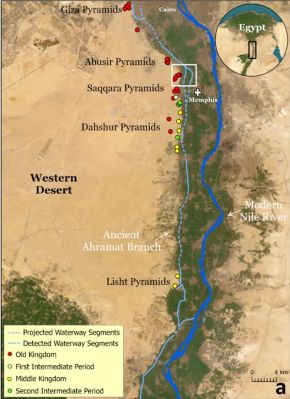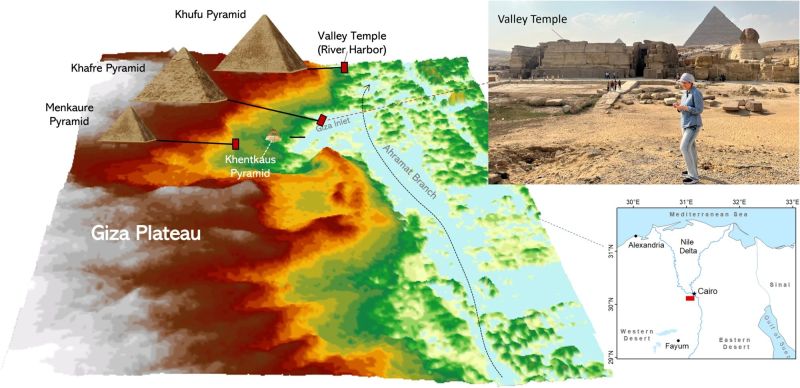Although we usually imagine the conditions in Ancient Egypt to be much like the Egypt of today, back during the Holocene there was significantly more rain as a result of the African Humid Period (AHP). This translated in the river Nile stretching far beyond its current range, with many more branches. This knowledge led a team of researchers to test the hypothesis that the largest cluster of pyramids in the Nile Valley was sited along one of these now long since vanished branches. Their findings are described in an article published in Communications Earth & Environment, by [Eman Ghoneim] and colleagues.

The CliffsNotes version can be found in the accompanying press release by the University of North Carolina Wilmington. Effectively, the researchers postulated that a branch of the Nile existed along these grouping of pyramids, with their accompanying temples originally positioned alongside this branch. The trick was to prove that a river branch once existed in that area many thousands of years ago.
What complicates this is that the main course of the Nile has shifted over the centuries, and anthropogenic activity has obscured much what remained, making life for researchers exceedingly difficult. Ultimately a combination of soil core samples, geophysical evidence, and remote sensing (e.g. satellite imagery) helped to cement the evidence for the existence what they termed the Ahramat Nile Branch, with ‘ahramat’ meaning ‘pyramids’ in Arabic.
Synthetic Aperture Radar (SAR) and high-resolution radar elevation data provided evidence for the Nile once having traveled right past this string of pyramids, also identifying the modern Bahr el-Libeini canal as one of the last remnants of the Ahramat Branch before the river’s course across the floodplain shifted towards the East, probably due to tectonic activity. Further research using Ground Penetrating Radar (GPR) and Electromagnetic Tomography (EMT) along a 1.2 km section of the suspected former riverbed gave clear indications of a well-preserved river channel, with the expected silt and sediments.
Soil cores to a depth of 20 and 13 meters further confirmed this, showing not only the sediment, but also freshwater mussel shells at 6 meter depth. Shallow groundwater was indicated at these core sites, meaning that even today subsurface water still flows through this part of the floodplain.
These findings not only align with the string of pyramids and their causeways that would have provided direct access to the water’s edge, but also provided hints for a further discovery regarding the Bent Pyramid — as it’s commonly known — which is located deep inside the desert today. Although located far from the floodplain by about a kilometer, its approximately 700 meters long causeway terminates at what would have been a now extinct channel: the Dahshur Inlet, which might also have served the Red Pyramid and others, although evidence for this is shakier.
Altogether, these findings further illustrate an Ancient Egypt where the Old Kingdom was followed by a period of severe changes, with increasing drought caused by the end of the AHP, an eastwardly migrating floodplain and decreased flow in the Nile from its tributaries. By the time that European explorers laid eyes on the ancient wonders of the Ancient Egyptian pyramids, the civilization that had birthed them was no more, nor was the green and relatively lush environment that had once surrounded it.
















Climate change even then.
But not anthropogenic climate change.
Yet another case of humanity looking at some natural disaster and saying “Hold my beer”.
Anthropogenic is also from Nature, but yes. I just say this because your comment reminded me of the George Carlin bit: “What’s the meaning of life? PLASTIC!”
I don’t necessarily see the need for a branch. It’s long been known that as mentioned in the article the Nile’s course is a meander. But I bow to the littoral boffins. And then there’s Maude: “and anthropogenic activity has obscured much what remained” Huh what now? Name *one*, won’t you?
A pretty comprehensive article on the African Humid Period (AHP) is here https://encyclopedia.pub/entry/33354 . Thanks to the HaD writer for spelling out acronyms on first use like you’re supposed to. Looking at you, every other HaD writer.
What does HaD mean?
Hack a Day
You’re welcome.
I see what you did there! ;-)
Strange site, that “article” is basically a copy of the Wikipedia entry for AHP.
Re anthropogenic activity: like a few thousand years of farming and building cities
Ah, the elegance and unassailable accuracy of the English language…
“…The Ancient River That Was Once Overlooked By The Egyptian Pyramids”
So, the Egyptian pyramids disregarded, ignored, failed to notice, and / or neglected the the Nile river, eh?
How absolutely churlish of those pyramids. Where do they get off adopting such a superior, entitled attitude. ?
Denial of the Nile is a river in Egypt.
The language of the Angles presupposes that you have the human capacity to discern from context that an inanimate pile of bricks isn’t capable of neglecting an inanimate body of water, except perhaps poetically. Apparently this is too much for some.
Ambiguous writing wastes the reader’s time
So, the Old Testament person [Joseph] may have been in Egypt as the AHP was winding down and prepared them for the oncoming drought.
‘I am Moses, I am Moses!’
A loony, before the Romans made up Jesus.
You know, if you reflexively discount stories which eventually worked their way into myth or religion, you will end up throwing out a lot of real history. It only follows that significant figures, after a time, came to be told of in flowery prose and hyperbole. Isn’t that what always happens? You can’t believe every legend verbatim on its own merit, but for the very same reason you also can’t reject the notion that perhaps there were real events which inspired it.
Would you really risk a misunderstanding of your own place in the universe and your own ancestor’s stories (and those of others).. all for the sake of flexing some 2010’s Reddit-branded atheism online?
The bible was edited (by a committee) at the council of Nicia.
IIRC under Charlemagne the genocidal. Convert or die!
There are about 8000 ‘Jesus story’ fragments known from before that date, no two have the same language. Many were banned/burned by the above committee.
There was likely a Koresh like loony named Jesus. His story was likely blended with others, to produce the desired political document.
All relatively recent ‘prophets’ can be proven (to a legal standard) to be swindlers (e.g. Joe Smith, L Ron, Mohammed). I infer that they ALL were.
Could be wrong.
Perhaps we all should be worshiping 3000 year old fire. Fire is cool!
The ancient Jews saying ‘we built the pyramids’ is _obvious_ political propaganda. Like Joan of Arc and the frogs. No chance it’s true. Old lies.
It has been well established for decades that Moses is mythical. The demonstration that Jesus is mythical is only a decade old (see Richard Carrier). Jesus is not a Roman invention, he is the creation of a Jewish sect and the tale expanded by others. Theism is not falsified by either Jesus or Moses being unreal.
Modern historians are doing a lot of careful work; standards for ancient history are much higher now than they were before 1950. Scholarship is doing an astonishingly good job of separating exaggerated history from whole-cloth lies.
Truth matters; myth cannot establish “your own place in the universe”. Stories should be understood as fiction and strictly separated from fact.
He drove his Chevas to Levi but the levee was dry.
It’s amazing what we have been able to re-assemble from the remote past, to glean a picture of what great old Egypt was like.. Whole deserts overturned, continents almost unrecognizable today. One cannot forget that, if it weren’t for Napoleon’s soldiers finding the Rosetta stone being used as a brick in a wall at the back of some street market, we likely still wouldn’t understand a bit of the Egyptian language.
If a soldier was a bit less curious… If the locals decided to turn it the other way around… If they denied the French to take it home and study it.. If we forgot one of the other languages on the stone.. Who knows how many chance serendipities were required to unravel that mystery?
And even more interesting, who knows how many mysteries exist even further back, mysteries for which we never had the luck and brilliance necessary to unravel? How did people really speak in 30,000 BC, how did they worship, how did they dress during their most precious and ostentatious moments? We have the most sparse of clues. So many things could be lost in time. The imagination can only run wild.
I think, the pyramids were made to escape flooding
As a reader of Graham Hancock and others over the years, this would make sense that the pyramids were built close to the Nile as it was then. I think the pyramids are at least 12,000 years old and the Sphinx is about 10,000 years old.
He’s a fool. I build them 25k years ago – carried the stones with what you know as “noah’s arc” -, but with the age I completeley forgot about them. Once in 10k years a crocodile with a suitcase made out of human skin comes and asks if I want insurance for them. Since they are looking so shabby today compared to when they were new, I think the crocodile won’t come back. Wanna hear the story about how I invented cricket in Stonehenge or when I lost my roomba in Roswell?